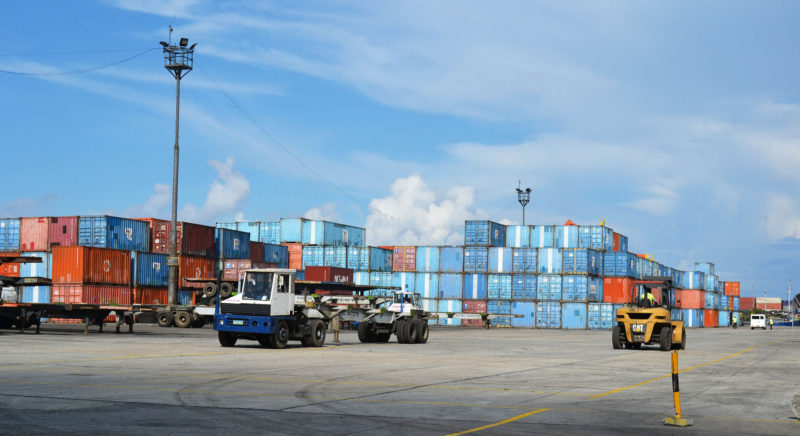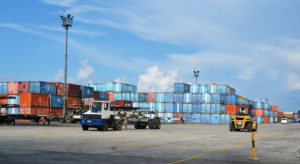

The Philippine Ports Authority (PPA) has approved a 24% increase in cargo-handling tariff at the Manila North Harbor, a decision found “unwarranted” by some industry stakeholders.
The hike will be divided in three equal tranches of 8% each, to be implemented over three years. The first tranche takes effect on July 21, the second in July 2018, and the last in July 2019.
By July 21, the new rate for loose or non-containerized cargo will be P232.07 or P17.19 higher while a 20-foot container will be charged P123.67 more or a total of P1,669.60, PPA said in a statement.
“The staggered implementation and the non-compounded basis” of the rate hike, which are based on January 2015 rates, are aimed at cushioning the impact of the increase on the public, PPA general manager Jay Daniel R. Santiago said.
PPA noted that the impact of the hike will be “negligible” at “less than a centavo or P0.004 centavo… added for a sack of rice passing through the North Harbor…”
Asked for comments, industry stakeholders referred PortCalls to position papers they submitted in 2016, the first time a public hearing was called to tackle the proposed increase. The position papers were all against the rate hike.
The approved 24% increase is lower than the 37.5% one-time hike requested in 2015 by port operator Manila North Harbour Port, Inc. (MNHPI). MNHPI sought the hike on account of ballooning costs.
The hike comes after PPA granted MNHPI a 10% provisional rate increase in 2013 and an 8% tariff rate increase in 2014.
In Memorandum Circular (MC) No. 004-2017, PPA said the latest adjustment is pursuant to Executive Committee Board Resolution Nos. 2017-1510 and 2017-1513, and as approved by Board Resolution No. 2619.
Santiago pointed out that MNHPI has so far infused some P5 billion in investments from the time it took over operations of the port in 2010. MNHPI is set to invest about P14.5 billion from 2010 to 2035.
During the first public hearing in 2016, MNHPI provided a position paper that said the cost of operating Manila North Harbor has risen, as the port has “higher cost components owing to higher cost of living” compared to other major ports in the country such as Davao, Cebu, and Batangas.
It added that the request for a tariff adjustment reflects increases in various cost structures and components, supports competitiveness of operations, and ensures the effective discharge of services to various port users.
The petition, the company said, was computed based on four cost drivers: labor, fuel, power, and maintenance of cargo-handling equipment.
At the same public hearing, MNHPI chief finance officer Ariel Victoria said they had computed the impact of the planned increase on commodities. For rice, an additional P0.04 would be added per kilogram of the staple in a twenty footer, while P0.08 was the additional cost per kilogram of banana in a TEU. Added cost on steel was computed at P0.08 per revenue ton.
General opposition to rate hike
Stakeholders during the public hearing in 2016 expressed “strong reservations” to the petition, saying the rate was too high and unwarranted.
READ: Carriers, shippers reject 37% tariff hike petition of Manila port operator
Then Supply Chain Management Association of the Philippines (SCMAP) president Corazon Curay observed that the proposed 37% increase was “very high” and would be borne by shippers and, eventually, consumers. She added that the tariff adjustment should consider economies of scale and port volume, which have increased based on the MNHPI presentation.
In its position paper dated June 1, 2016, SCMAP said the tariff increase was “not justified,” given the increase in port volume brought forth by the growth of the national economy, as well as the lower cost of fuel and the stable cost of power. These factors should have generated economies of scale and cost savings, it added.
It further stated that based on MNHPI figures, the higher expenditure was driven more by an increase in port usage rather than costs.
Although the rate that was finally approved by PPA is less than what MNHPI originally sought, SCMAP told PortCalls its position on the increase remains unchanged.
The Philippine Liner Shipping Association (PLSA), also in a 2016 position paper, described the MNHPI petition as “unwarranted”.
According to MNHPI’s audited financial statements for 2012, 2013, and 2014, PLSA said “there is proportionate revenue earned to compensate for every cost incurred for any cost driver reflected as expense computed per TEU.”
It added that “MNHPI failed to consider this but instead charged to stakeholders such unreasonable and very questionable incremental expense on its cost drivers.”
On the impact on commodities, PLSA said that while the increase would appear to be small per kilogram, MNHPI’s computation “failed to show the impact of the increase based on the annual total volume in TEUs carried outbound and inbound Manila.”
The Philippine Exporters Confederation, Inc. (Philexport) also maintains its position on the rate increase, which echoes that of PLSA’s. Philexport noted that a significant number of its members utilize the port to transport locally sourced materials between the Visayas and Mindanao regions, and to deliver products intended for domestic trade. – Roumina Pablo




